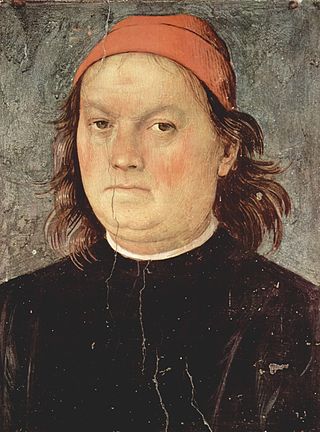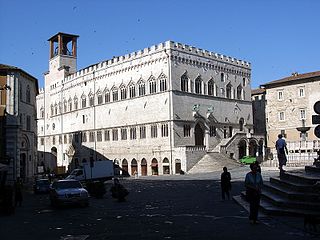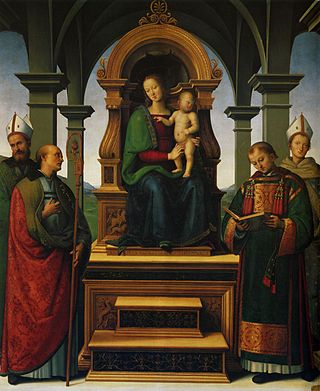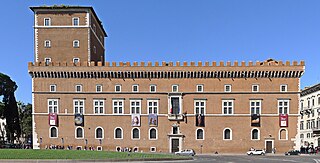
Perugia is the capital city of Umbria in central Italy, crossed by the River Tiber, and of the province of Perugia. The city is located about 164 km (102 mi) north of Rome and 148 km (92 mi) southeast of Florence. It covers a high hilltop and part of the valleys around the area. The region of Umbria is bordered by Tuscany, Lazio, and Marche.

Pinturicchio, or Pintoricchio, also known as Benetto di Biagio or Sordicchio, was an Italian painter during the Renaissance. He acquired his nickname because of his small stature and he used it to sign some of his artworks that were created during the fifteenth and sixteenth centuries.

Benedetto Bonfigli was an Italian Renaissance painter born in Perugia, and part of the Umbria school of painters including Raphael and Perugino. He is also known as Buonfiglio. Influenced by the style of Domenico Veneziano, Benozzo Gozzoli, and Fra Angelico, Bonfigli primarily painted frescos for the church and was at one point employed in the Vatican. His best-preserved work is the Annunciation, but his masterpiece is the decoration of the chapel of the Palazzo dei Priori. Bonfigli specialized in gonfaloni, a Perugian style using banners painted on canvas or linen. Little is known of his personal life, but he was an esteemed painter in Perugia before Perugino, who is said to be his pupil.

Pietro Perugino, born Pietro Vannucci, was an Italian Renaissance painter of the Umbrian school, who developed some of the qualities that found classic expression in the High Renaissance. Raphael was his most famous pupil.

Fiorenzo di Lorenzo was an Italian painter, of the Umbrian school. He lived and worked at Perugia, where most of his authentic works are still preserved in the Galleria Nazionale dell'Umbria.

Benozzo Gozzoli was an Italian Renaissance painter from Florence. A pupil of Fra Angelico, Gozzoli is best known for a series of murals in the Magi Chapel of the Palazzo Medici-Riccardi, depicting festive, vibrant processions with fine attention to detail and a pronounced International Gothic influence. The chapel's fresco cycle reveals a new Renaissance interest in nature with its realistic depiction of landscapes and vivid human portraits. Gozzoli is considered one of the most prolific fresco painters of his generation. While he was mainly active in Tuscany, he also worked in Umbria and Rome.

Montefalco is a historic small hill town in Umbria, Italy, with a population of 5,581 in August 2017. It has been settled since pre-Roman times, and retains many of its historic buildings. From 1446 to 1861 it was part of the Papal States. It is one of I Borghi più belli d'Italia.

Antoniazzo Romano, born Antonio di Benedetto Aquilo degli Aquili was an Italian Early Renaissance painter, the leading figure of the Roman school during the latter part of the 15th century. He "made a speciality of repainting or interpreting older images, or generating new cult images with an archaic flavor", in particular by very often using the gold ground style, which was unusual by this period.

The basilica diSan Pietro is a Catholic basilica and abbey in the Italian city of Perugia. Its bell tower, standing at 70 meters tall, is the tallest structure in Perugia and is one of the city's most significant symbols. It is an Italian national monument

Niccolò di Liberatore, known as L'Alunno (1430–1502) was an Italian painter of the Umbrian school.

The Savoy Gallery is an art collection in the Italian city of Turin, which contains the royal art collections amassed by the House of Savoy over the centuries. It is located on Via XX Settembre, 86.
The decade of the 1430s in art involved some significant events.

The Palazzo dei Priori or comunale is one of the best examples in Italy of a public palace from the communal era. It is located in the central Piazza IV Novembre in Perugia, Umbria. It extends along Corso Vannucci up to Via Boncambi. It still houses part of the municipality, and, on the third floor, the Galleria Nazionale dell'Umbria. It takes its name from the Priori, the highest political authority governing the city in the medieval era.

Bartolomeo Caporali was an Italian painter and miniaturist in Perugia, Umbria during the early Renaissance period. His style was influenced by Umbrian artists Gozzoli and Boccati, two of his first mentors, and continued to evolve as younger Umbrian artists came onto the scene, such as Fiorenzo di Lorenzo, Perugino and Pinturicchio. Although primarily a painter, he is also known for executing missals, restoration work, gilding, armorials, banners and celebratory decorations, which speaks to his decorative, detail-oriented artistic style. His most famous works include Madonna and Saints (1487) for the church of Santa Maria Maddalena at Castiglione del Lago, The Virgin and Child Between Two Praying Angels, and his Adoration of the Shepherds.

San Domenico is a Roman Catholic basilica church, located on Piazza Giordano Bruno and via del Castellano in the city of Perugia, region of Umbria, central Italy.

Decemviri Altarpiece is a painting by the Italian Renaissance artist Pietro Perugino, executed in 1495–1496, and housed in the Pinacoteca Vaticana in Vatican City.

Carlo Spiridione Mariotti was an Italian painter; he often painted genre scenes.
Pompeo Cocchi di Pier Gentile was an Italian painter of the Renaissance period, active in Umbria.

The Museo Nazionale del Palazzo di Venezia is a state museum in Rome (Italy), housed in the palace of the same name together with the important Library of Archaeology and Art History.

Madonna and Child with St Herculanus and St Constantius or Madonna of the Kitchen is a 1515 painting by Perugino, now in the Galleria Nazionale dell'Umbria in Perugia. Its title refers to the fact that it once hung in the former kitchen of the Palazzo dei Priori in Perugia. The two accompanying saints are Herculanus and Constantius, both local saints to Perugia.



















